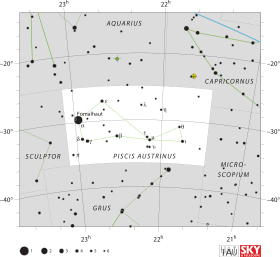Delta Piscis Austrini
Delta Piscis Austrini (δ Piscis Austrini) is a yellow-hued star[3] in the southern constellation of Piscis Austrinus. It is visible to the naked eye with an apparent visual magnitude of +4.175.[2] There is a magnitude 9.86[3] common proper motion[3] companion located at an angular separation of 5.2 arc seconds – the pair most likely form a binary star system.[10] Based upon an annual parallax shift of 18.9796 mas as seen from the Gaia satellite, Delta Piscis Austrini is located 172 ± 2 light-years from the Sun.[6]
 | |
| Observation data Epoch J2000.0 Equinox J2000.0 (ICRS) | |
|---|---|
| Constellation | Piscis Austrinus |
| Right ascension | 22h 55m 56.90026s[1] |
| Declination | −32° 32′ 22.6335″[1] |
| Apparent magnitude (V) | +4.175[2] (4.18 + 9.86)[3] |
| Characteristics | |
| δ PsA A | |
| Spectral type | G8 III[4] |
| U−B color index | +0.72[2] |
| B−V color index | +0.94[2] |
| δ PsA B | |
| Spectral type | G8 IV[3] |
| U−B color index | +0.77[3] |
| B−V color index | +0.67[3] |
| Astrometry | |
| Radial velocity (Rv) | −11.60[5] km/s |
| Proper motion (μ) | RA: +11.499 ± 0.398[6] mas/yr Dec.: +32.641 ± 0.379[6] mas/yr |
| Parallax (π) | 18.9796 ± 0.2558[6] mas |
| Distance | 172 ± 2 ly (52.7 ± 0.7 pc) |
| Absolute magnitude (MV) | +0.636[7] |
| Details | |
| δ PsA A | |
| Mass | 1.42[5] M☉ |
| Luminosity | 52[5] L☉ |
| Surface gravity (log g) | 2.72±0.10[5] cgs |
| Temperature | 4,828±29[5] K |
| Metallicity [Fe/H] | −0.21±0.10[8] dex |
| Age | 3.74[5] Gyr |
| Other designations | |
| Database references | |
| SIMBAD | data |
The primary, component A, is an evolved G-type giant star with a stellar classification of G8 III.[4] At the age of about 3.74 billion years[5] it is a red clump star, which indicates it is generating energy through helium fusion at its core.[7] The star has an estimated 1.42 times the mass of the Sun and it radiates 52 times the solar luminosity from its photosphere at an effective temperature of 4.828 K.[5]
Delta Piscis Austrini is moving through the Galaxy at a speed of 13.8 km/s relative to the Sun. Its projected Galactic orbit carries it between 24,000 and 35,300 light years from the center of the Galaxy.[11] It will come closest to the Sun 2.8 million years from now when it will brighten to magnitude 2.87 from a distance of 83 light years.[11]
Chinese name
The Chinese name for Delta Piscis Austrini is 天綱 (Tiān Gāng) meaning Materials for Making Tents, because this star is marking itself and stand alone in Materials for Making Tents asterism, Encampment mansion (see : Chinese constellation).[12] 天綱 (Tiān Gāng) westernized into Tien Kang, meaning "the Heavenly Rope" in R.H. Allen's work, but the name is for the asterism consisting this star, β PsA and ζ PsA.[13]
References
- van Leeuwen, F. (2007), "Validation of the new Hipparcos reduction", Astronomy and Astrophysics, 474 (2): 653–664, arXiv:0708.1752, Bibcode:2007A&A...474..653V, doi:10.1051/0004-6361:20078357.
- Rakos, K. D.; et al. (February 1982), "Photometric and astrometric observations of close visual binaries", Astronomy and Astrophysics Supplement Series, 47: 221–235, Bibcode:1982A&AS...47..221R.
- Corbally, C. J. (1984), "Close visual binaries. I - MK classifications", Astrophysical Journal Supplement Series, 55: 657, Bibcode:1984ApJS...55..657C, doi:10.1086/190973.
- Houk, Nancy (1979), Michigan catalogue of two-dimensional spectral types for the HD stars, 3, Ann Arbor, Michigan: Department of Astronomy, University of Michigan, Bibcode:1982mcts.book.....H.
- Luck, R. Earle (2015), "Abundances in the Local Region. I. G and K Giants", Astronomical Journal, 150 (3), 88, arXiv:1507.01466, Bibcode:2015AJ....150...88L, doi:10.1088/0004-6256/150/3/88.
- Brown, A. G. A.; et al. (Gaia collaboration) (August 2018). "Gaia Data Release 2: Summary of the contents and survey properties". Astronomy & Astrophysics. 616. A1. arXiv:1804.09365. Bibcode:2018A&A...616A...1G. doi:10.1051/0004-6361/201833051. Gaia DR2 record for this source at VizieR.
- Liu, Y. J.; et al. (2007), "The abundances of nearby red clump giants", Monthly Notices of the Royal Astronomical Society, 382 (2): 553–66, Bibcode:2007MNRAS.382..553L, doi:10.1111/j.1365-2966.2007.11852.x.
- Alves, S.; et al. (April 2015), "Determination of the spectroscopic stellar parameters for 257 field giant stars", Monthly Notices of the Royal Astronomical Society, 448 (3): 2749–2765, arXiv:1503.02556, Bibcode:2015MNRAS.448.2749A, doi:10.1093/mnras/stv189.
- "del PsA -- Star", SIMBAD Astronomical Database, Centre de Données astronomiques de Strasbourg, retrieved 2017-05-18.
- Eggleton, P. P.; Tokovinin, A. A. (September 2008), "A catalogue of multiplicity among bright stellar systems", Monthly Notices of the Royal Astronomical Society, 389 (2): 869–879, arXiv:0806.2878, Bibcode:2008MNRAS.389..869E, doi:10.1111/j.1365-2966.2008.13596.x.
- "Delta Piscis Austrini (HIP 113246)". Archived from the original on 2013-04-14. Retrieved 2012-08-24.
- (in Chinese) AEEA (Activities of Exhibition and Education in Astronomy) 天文教育資訊網 2006 年 7 月 6 日
- Richard Hinckley Allen: Star Names — Their Lore and Meaning: Piscis Australis, the Southern Fish